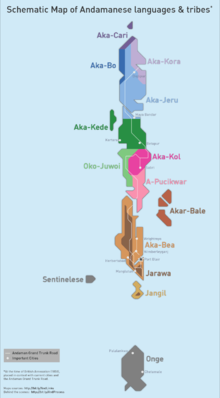Aka-Bea language
| Bea | |
|---|---|
| Aka-Bea | |
| Native to | India |
| Region | Andaman Islands; South Andaman island except northeast coast, and north and east interiors; Rutland island except south coast; small islands southeast of Rutland; Labyrinth Islands. |
| Extinct | by 1931 |
|
Great Andamanese
|
|
| Language codes | |
| ISO 639-3 | |
| Glottolog | akab1249 |
 |
|
The Bea language, Aka-Bea, is an extinct Great Andamanese language of the Southern group. It was spoken around the western Andaman Strait and around the northern and western coast of South Andaman.
The Bea were one of the indigenous peoples of the Andaman Islands, one of the ten or so Great Andamanese tribes identified by British colonials in the 1860s. Their language was closely related to the other Great Andamanese languages. They were extinct as a distinct people by 1931.
The Great Andamanese languages are agglutinative languages, with an extensive prefix and suffix system. They have a distinctive noun class system based largely on body parts, in which every noun and adjective may take a prefix according to which body part it is associated with (on the basis of shape, or functional association). Thus, for instance, the *aka- at the beginning of the language names is a prefix for objects related to the tongue. An adjectival example can be given by the various forms of yop, "pliable, soft", in Aka-Bea:
Similarly, beri-nga "good" yields:
The prefixes are,
Body parts are inalienably possessed, requiring a possessive adjective prefix to complete them, so one cannot say "head" alone, but only "my, or his, or your, etc. head".
The basic pronouns are almost identical throughout the Great Andamanese languages; Aka-Bea will serve as a representative example (pronouns given in their basic prefixal forms):
'This' and 'that' are distinguished as k- and t-.
Judging from the available sources, the Andamanese languages have only two cardinal numbers — one and two — and their entire numerical lexicon is one, two, one more, some more, and all.
...
Wikipedia
